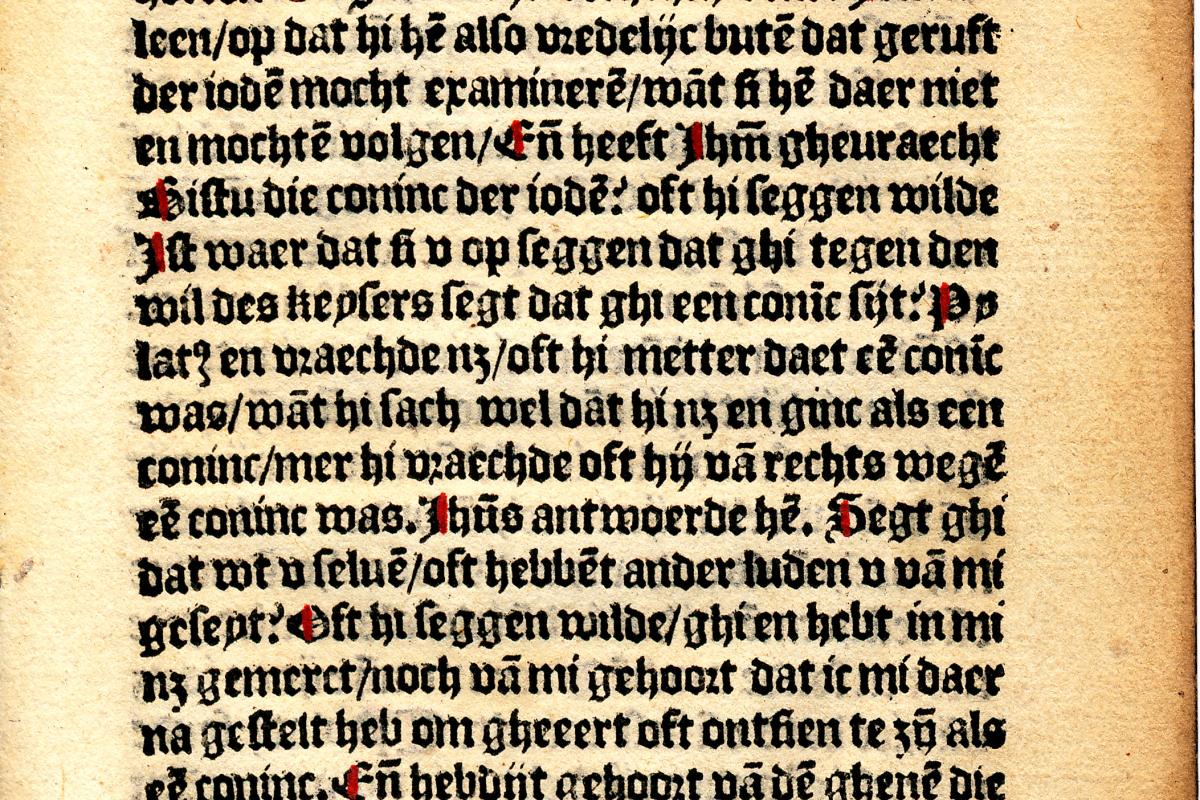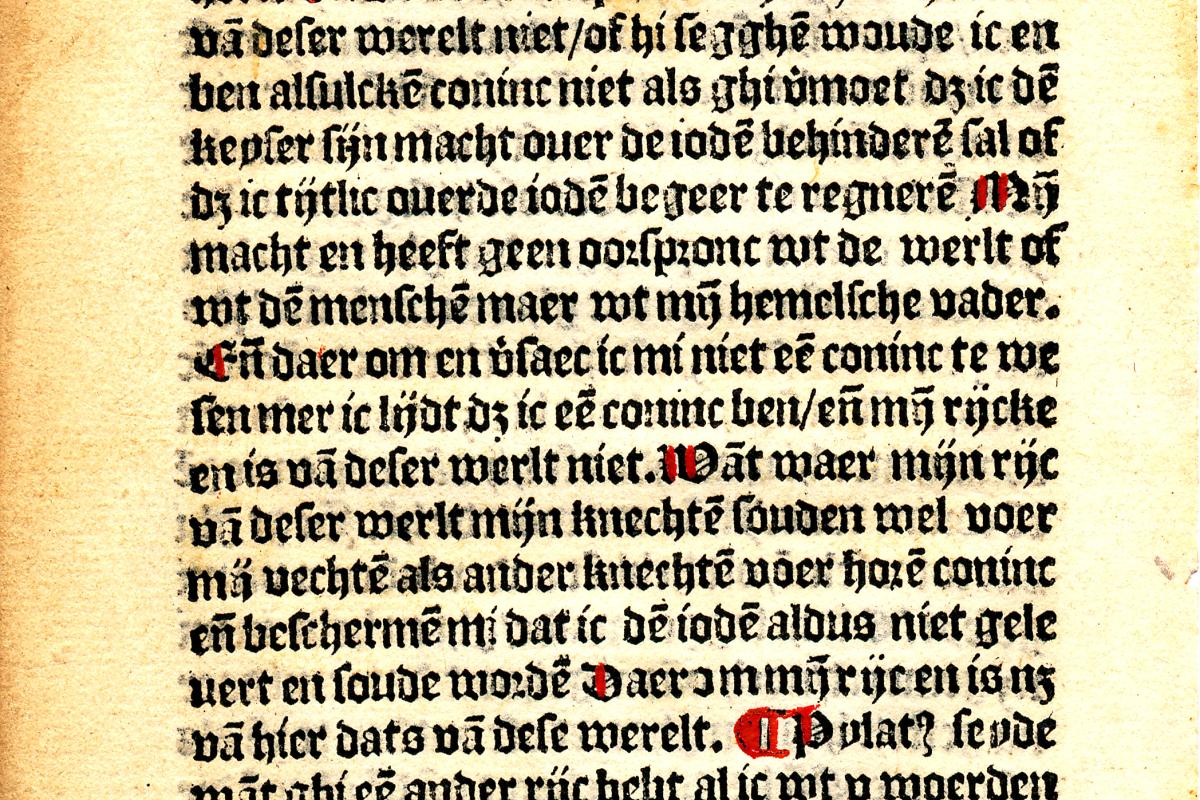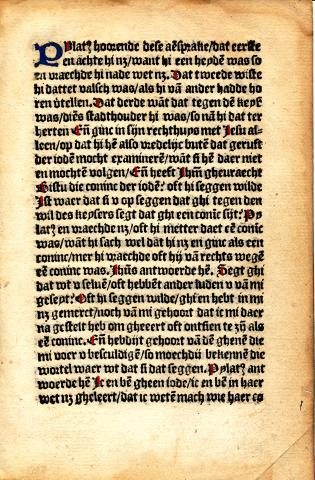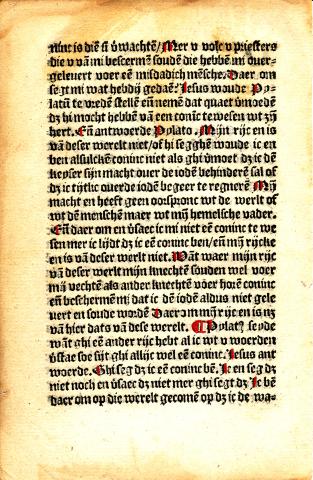Leaf from Fasciculus mirre
Leaf from Fasciculus mirre
Germanic, Dutch, Flemish,
Delft, 1500 (possibly as late as 1517)
Author: Unknown
Language: Middle Dutch
Printer: Roelant Bollaert (possibly Hugo Jansz van Woerden)
Ink on paper
height: 14cm
width: 9cm
Portland State University Library Special Collections, Shipley 1
Travis Stone, Medieval Portland Capstone Student, Spring 2016
Fasciculus mirre is a Germanic devotional book that was popular in the Low Countries in the early sixteenth century. The text contains meditations on the life of Jesus Christ, most notably the Passion.[1] Its Latin title (meaning “a bundle of myrrh” in English) comes from the first chapter of Canticum Canticorum (known also as the Song of Songs): “Fasciculus Myrrhae dilectus meus mihi inter ubera mea commorabituris.”[2] Fasciculus mirre is often sometimes spelled as Fasciculus myrre or myrrhæ and can also be referred to by an English title, On the Life of Christ.[3] The earliest known printed version dates to approximately 1500 CE.[4] The content of the devotional book was first compiled by an anonymous Franciscan in the German city of Cologne, although the exact date of its original composition is unknown.[5]
During a time when Europe was on the eve of the Protestant Reformation, the pocket-sized text was convenient for those who could carry it around with them everywhere, reading it throughout the day and embracing the spiritual power it was believed to embody.[6] Following the expansion of both the printing press and the Reformation during the first half of the sixteenth century, various editions of the book were widely circulated throughout the Low Countries while the region was under the control of Charles V and the Holy Roman Empire. Between 1518 and 1550, twenty separate editions of Fasciculus mirre were printed in the bustling, mercantile hub of Antwerp,[7] a city that was becoming an epicenter of commercial printing as well as a popular safe haven for non-Catholic religious movements such as Calvinism and Lutheranism.[8]
Today, Fasciculus mirre continues to be a curious obscurity in the vast realm of devotional literature and incunabula. Fully intact copies are rare but can be found through the Universal Short Title Catalogue database.[9] Typically, only leaves are available within the United States, either in museums or in University Special Collections.
The leaf from Fasciculus mirre housed at Portland State University measures 14 centimeters in length and 9 centimeters in width. It contains 26 lines in Middle Dutch,[10] printed using the then-favored Gothic script.[11] The paper used has a high fiber and cotton content, as opposed to wood fiber.[12] There are brown stains around the outer edges of the page, but the colors of the blue ink used for the first letter of the page and the red ink for the upper case letters throughout are still vibrant after nearly five hundred years.[13]
The details surrounding the production of this leaf’s original, complete manuscript are clouded in mystery. According to Foliophiles,[14] it was printed by Roelant Bollaert in the Dutch city of Delft circa 1500.[15] Portland State received the leaf as part of Foliophiles’ 1964 collection entitled ‘History of the Written Word,’ which included twenty sets of the Fasciculus mirre leaf. Interestingly, leaves from similar Foliophiles’ collections are housed across the United States at the University of South Carolina, the University of Missouri, Western Michigan University, and the Indiana University of Pennsylvania—all of which attribute the leaf to Bollaert in Delft, circa 1500.[16]
However, it is possible that all of these leaves were printed by someone else entirely, and were, in fact, from the year 1517.[17] A file dated 8/16/2006—the date Portland State received the Foliophiles set, including the leaf in question—specifies that the leaf came from an edition printed by ‘Hugo Lansoon of Woerden’ on March 6, 1517.[18] According to the Universal Small Title Catalogue (an online database hosted by the University of Saint Andrews in Scotland), Hugo Jansz[19] of Woerden in 1517 was the only edition printed in Delft.[20] 29 separate editions are included in this database, all of which were printed in the Low Countries between 1504 and 1578: 24 are from Antwerp, three are from Leiden, and one is from The Hague. Finally, only one edition, not two, was printed in Delft: the 1517 edition by Hugo Jansz of Woerden. The database includes nothing by Roelant Bollaert in the year 1500.[21]
Further speculation derives from the fact that in 1524, Bollaert was the journeyman as well as the servant of Margriete Dregghe, the widow of Henrick Eckert van Homberch (a printer and book dealer who printed an edition of Fasciculus mirre in Antwerp in 1518, shortly before his death.)[22] Bollaert also did not become a citizen of Antwerp until 1525/6.[23] Regardless, he may have printed an edition of Fasciculus mirre in Delft 24 years earlier, where he may have been a citizen or a member of a guild that would have authorized him to do so; however, there is no evidence supporting this. Perhaps he moved to Antwerp in the 1510s or 20s, a major center of European printing at the time, to become a member of a guild—such as the Guild of Saint Luke—after establishing relationships with members of Saint Luke’s, such as Henrick Eckert van Homberch himself? Again, there is very little evidence detailing the life and work of Roelant Bollaert.
Did, in fact, the Foliophiles collectors in the 1960’s make a mistake? After all, the date is specified as circa 1500 on the identification cards that are issued with each leaf. And where did the file from August 2006 come from, the one that attributes the leaf to Janszoon in 1517? Unfortunately, the confirmation of the exact date and the printer of these leaves could end up being a matter doomed to only speculation, and perhaps it is something that will never be fully resolved. Nevertheless, these leaves of Fasciculus mirre offer a glimpse into the daily religious culture of the Netherlands during a time when it was on the brink of the horrific and violent effects of the Protestant Reformation as well as when the small (yet prolific) country was beginning to sow the seeds of the Dutch Golden Age.
NOTES
[1] Miguel Ángel Pallarés Jiménez. “Algunas Reflexiones Sobre El Inicio de la Tipografía en Zaragoza y Aragón: Cambios Pervivencias en la Transición del Códice al Impreso.” Universidad de Zaragoza (2002): 114. http://ifc.dpz.es/recursos/publicaciones/32/44/05pallares.pdf; Bert Roest. “Franciscans Between Observance and Reformation: The Low Countries (ca. 1400-1600),” Franciscan Studies 63 (2005): 429-31.
[2] Roest, “Franscicans Between Observance and Reformation,” 431.
[3] Indiana University of Pennsylvania Special Collections and University Archives. Pages from the Past: Original Leaves from Rare Books and Manuscripts: Manuscript Group 178 (Jan. 29, 2015): 7.
[4] Portland State University Library of Special Collections. Pages from the Past: Original Leaves from Rare Books and Manuscripts. Portfolio Set I: History of the Written Word. Washington, D.C.: Foliophiles, 1964.
[5] Pallarés Jiménez, “Algunas Reflexiones Sobre El Inicio de la Tipografía en Zaragoza y Aragón,” 114.
[6] Roest, “Franscicans Between Observance and Reformation,” 428-33.
[7] Universal Short Title Catalogue. The University of Saint Andrews. http://ustc.ac.uk/index.php/search/cicero?tm_fulltext=&tm_field_allauthr=Fasciculus+mirre&tm_translator=&tm_editor=&tm_field_short_title=&tm_field_imprint=&tm_field_place=&sm_field_year=&f_sm_field_year=&t_sm_field_year=&sm_field_country=&sm_field_lang=&sm_field_format=&sm_field_digital=&tm_field_class=&tm_field_cit_name=&tm_field_cit_no=&order=year_asc&start=0&sm_field_std_place= This database includes a list of 29 different editions of Fasciculus mirre that were printed in various Dutch cities between 1504 and 1578.
[8] Matthijs de Lok. Review of Antwerp in the Age of Reformation: Underground Protestantism in a Commercial Metropolis 1550-1577 by Guido Marnef. Michigan State University Department of History. H-Net: Humanities & Social Sciences Online (Jan. 1998). http://www.h-net.org/reviews/showrev.php?id=1619
[9] See note 7.
[10] “Middle Dutch.” Wikipedia. https://en.wikipedia.org/wiki/Middle_Dutch. The text from the actual leaf greatly compares with that of Middle Dutch.
[11] Portland State University Library of Special Collections. Pages from the Past; See also, “Blackletter.” Wikipedia. https://en.wikipedia.org/wiki/Blackletter
[12] Carolee Harrison, Portland State University Library of Special Collections.
[13] Portland State University Library of Special Collections. Pages from the Past.
[14] For information on the Foliophiles, see http://spec.lib.miamioh.edu/home/preservation-measures-pages-from-the-past/
[15] Portland State University Library of Special Collections. Pages from the Past.
[16] For the University of South Carolina, see http://digital.tcl.sc.edu/cdm/search/collection/IOEPP/searchterm/Bollaert/field/all/mode/all/conn/and/order/title/ad/asc/cosuppress/0; For the University of Missouri, see http://dl.mospace.umsystem.edu/mu/islandora/object/mu%3A307629#page/1/mode/2up; For Western Michigan University, see https://archon.library.wmich.edu/?p=collections/findingaid&id=115&q=; For the Indiana University of Pennsylvania, see http://libs0500.library.iup.edu/depts/speccol/All%20Finding%20Aids/Finding%20aids/MG%20or%20Col/MG178Word.pdf
[17] For example, see http://www.biblio.com/book/early-printed-leaf-fasciculus-mirre-matthijs/d/455321413
[18] Portland State University Library of Special Collections. Pages from the Past.
[19] Jansz is an alternative, shortened spelling of Janszoon; the name ‘Lansoon’ in PSU’s file could have been written down incorrectly—as it was perhaps meant to say Janszoon.
[20] “Fasciculus mirre: hier beghint een seer sonderlinghe ende devote materie van die Passie ons heren Jhesu Cristi, gheheten (Dat busselkijn, of, dat bondekyn van mirre): Delft, Hugo Jansz van Woerden, 1517.” From the Universal Short Title Catalogue. The University of Saint Andrews. http://ustc.ac.uk/index.php/record/425607
[21] Universal Short Title Catalogue. The University of Saint Andrews.
[22] Jan Van Der Stock. Printing Images in Antwerp: The Introduction of Printmaking in a City: Fifteenth Century to 1585 (Rotterdam: Sound & Vision Interactive, 1998), 263.
[23] Ibid.
BIBLIOGRAPHY
de Lok, Matthijs. Review of Antwerp in the Age of Reformation: Underground Protestantism in a Commercial Metropolis 1550-1577 by Guido Marnef. Michigan State University Department of History. H-Net: Humanities & Social Sciences Online (Jan. 1998). http://www.h-net.org/reviews/showrev.php?id=1619
Indiana University of Pennsylvania Special Collections and University Archives. Pages from the Past: Original Leaves from Rare Books and Manuscripts: Manuscript Group 178 (Jan. 29, 2015): 1-9. http://libs0500.library.iup.edu/depts/speccol/All%20Finding%20Aids/Finding%20aids/MG%20or%20Col/MG178Word.pdf
Pallarés Jiménez, Miguel Ángel. “Algunas Reflexiones Sobre El Inicio de la Tipografía en Zaragoza y Aragón: Cambios Pervivencias en la Transición del Códice al Impreso.” Universidad de Zaragoza (2002): 67-133. http://ifc.dpz.es/recursos/publicaciones/32/44/05pallares.pdf
Portland State University Library of Special Collections. Pages from the Past: Original Leaves from Rare Books and Manuscripts. Portfolio Set I: History of the Written Word. Washington, D.C.: Foliophiles, 1964.
Roest, Bert. “Franciscans Between Observance and Reformation: The Low Countries (ca. 1400-1600).” Franciscan Studies 63 (2005): 409-42.
Stock, Jan Van Der. Printing Images in Antwerp: The Introduction of Printmaking in a City: Fifteenth Century to 1585. Studies in Prints and Printmaking; v. 2. Rotterdam: Sound & Vision Interactive, 1998.
Universal Short Title Catalogue. The University of Saint Andrews. http://ustc.ac.uk/index.php/search/cicero?tm_fulltext=&tm_field_allauthr=Fasciculus+mirre&tm_translator=&tm_editor=&tm_field_short_title=&tm_field_imprint=&tm_field_place=&sm_field_year=&f_sm_field_year=&t_sm_field_year=&sm_field_country=&sm_field_lang=&sm_field_format=&sm_field_digital=&tm_field_class=&tm_field_cit_name=&tm_field_cit_no=&order=year_asc&start=0&sm_field_std_place=




